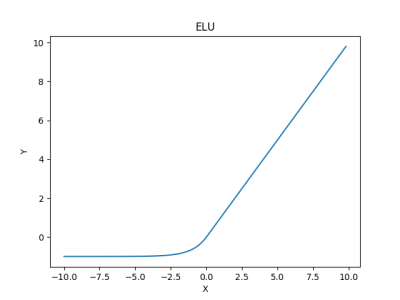Exponential Linear Activation Function
An Exponential Linear Activation Function is a Rectified-based Activation Function that is based on the mathematical function: [math]\displaystyle{ f(x)=max(0,x)+min(0,\alpha∗(\exp(x)−1)) }[/math] where [math]\displaystyle{ \alpha }[/math] a positive hyperparameter.
- AKA: ELU.
- Context:
- It can (typically) be used in the activation of Exponential Linear Neurons.
- Example(s):
- Counter-Example(s):
- a Clipped Rectifier Unit Activation Function,
- a Concatenated Rectified Linear Activation Function,
- a Leaky Rectified Linear Activation Function,
- a Noisy Rectified Linear Activation Function,
- a Parametric Rectified Linear Activation Function,
- a Randomized Leaky Rectified Linear Activation Function,
- a Scaled Exponential Linear Activation Function,
- a Softplus Activation Function,
- a S-shaped Rectified Linear Activation Function.
- See: Artificial Neural Network, Artificial Neuron, Neural Network Topology, Neural Network Layer, Neural Network Learning Rate.
References
2018a
- (Pytorch, 2018) ⇒ http://pytorch.org/docs/master/nn.html#elu Retrieved:2018-2-10
- QUOTE:
class torch.nn.ELU(alpha=1.0, inplace=False)sourceApplies element-wise, [math]\displaystyle{ f(x)=max(0,x)+min(0,alpha∗(exp(x)−1)) }[/math]
Parameters:
*** alpha – the alpha value for the ELU formulation. Default: 1.0
- inplace – can optionally do the operation in-place. Default:
False
- inplace – can optionally do the operation in-place. Default:
- QUOTE:
- Shape:
- Input: (N,∗) where * means, any number of additional dimensions
- Output: (N,∗), same shape as the input
- Examples:
- Shape:
>>> m = nn.ELU() >>> input = autograd.Variable(torch.randn(2)) >>> print(input) >>> print(m(input))
2018b
- (TensorFlow.org, 2018) ⇒ https://www.tensorflow.org/versions/r0.12/api_docs/python/nn/activation_functions_#elu Retrieved: 2018-2-18
- QUOTE:
tf.nn.elu(features, name=None)Computes exponential linear: exp(features) - 1 if < 0, features otherwise.
See Fast and Accurate Deep Network Learning by Exponential Linear Units (ELUs)
Args:
features: ATensor. Must be one of the following types:float32,float64,int32,int64,uint8,int16,int8,uint16,half.name: A name for the operation (optional).
- QUOTE:
- Returns:
A
Tensor. Has the same type asfeatures.
- Returns:
2018c
- (Chainer, 2018) ⇒ http://docs.chainer.org/en/stable/reference/generated/chainer.functions.elu.html Retrieved:2018-2-18
- QUOTE:
chainer.functions.elu(x, alpha=1.0)source Exponential Linear Unit function.
For a parameter [math]\displaystyle{ \alpha }[/math], it is expressed as
[math]\displaystyle{ f(x) = \begin{cases} x & \mbox{if } x \geq 0 \\ \alpha(\exp(x)-1) & \mbox{otherwise} \end{cases} }[/math]
See: https://arxiv.org/abs/1511.07289
Parameters:
- x (Variable or
numpy.ndarrayorcupy.ndarray) – Input variable. A [math]\displaystyle{ (s_1,s_2,\cdots,s_N) }[/math]-shaped float array. - alpha (float) – Parameter [math]\displaystyle{ \alpha }[/math]. Default is 1.0.
- x (Variable or
- QUOTE:
- Returns: Output variable. A [math]\displaystyle{ (s_1,s_2,\cdots,s_N) }[/math]-shaped float array.
- Return type: Variable
- Example:
>>> x = np.array([ [-1, 0], [2, -3] ], 'f')
>>> x
array([ [-1., 0.],
[ 2., -3.] ], dtype=float32)
>>> y = F.elu(x, alpha=1.)
>>> y.data
array([ [-0.63212055, 0. ],
[ 2. , -0.95021296] ], dtype=float32)
2018d
- (Wikipedia, 2018) ⇒ https://en.wikipedia.org/wiki/Rectifier_(neural_networks)#ELUs Retrieved:2018-2-5.
- Exponential linear units try to make the mean activations closer to zero which speeds up learning. It has been shown that ELUs can obtain higher classification accuracy than ReLUs. [math]\displaystyle{ f(x) = \begin{cases} x & \mbox{if } x \geq 0 \\ a(e^x-1) & \mbox{otherwise} \end{cases} }[/math]
[math]\displaystyle{ a }[/math] is a hyper-parameter to be tuned and [math]\displaystyle{ a \geq 0 }[/math] is a constraint.
- Exponential linear units try to make the mean activations closer to zero which speeds up learning. It has been shown that ELUs can obtain higher classification accuracy than ReLUs. [math]\displaystyle{ f(x) = \begin{cases} x & \mbox{if } x \geq 0 \\ a(e^x-1) & \mbox{otherwise} \end{cases} }[/math]
2017
- (Mate Labs, 2017) ⇒ Mate Labs Aug 23, 2017. Secret Sauce behind the beauty of Deep Learning: Beginners guide to Activation Functions
- QUOTE: Exponential Linear Unit (ELU) — Exponential linear units try to make the mean activations closer to zero which speeds up learning. It has been shown that ELUs can obtain higher classification accuracy than ReLUs. α is a hyper-parameter here and to be tuned and the constraint is [math]\displaystyle{ \alpha \ge 0 }[/math](zero).
Range: [math]\displaystyle{ (-\alpha,+\infty) }[/math]
[math]\displaystyle{ f(x) = \begin{cases} \alpha(e^x-1)x & \mbox{if } x \lt 0 \\ x & \mbox{if } x\ge 0 \end{cases} }[/math]
- QUOTE: Exponential Linear Unit (ELU) — Exponential linear units try to make the mean activations closer to zero which speeds up learning. It has been shown that ELUs can obtain higher classification accuracy than ReLUs. α is a hyper-parameter here and to be tuned and the constraint is [math]\displaystyle{ \alpha \ge 0 }[/math](zero).
